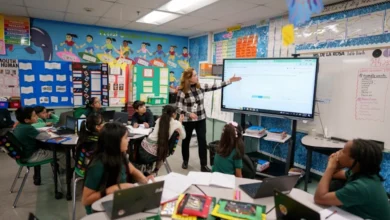International Literacy Day 2025: Promoting Literacy in the Digital Era

International Literacy Day is observed annually on September 8 to celebrate the power of reading and writing while spotlighting the millions of children who are still denied this basic right.
This year, the focus goes beyond books to the skills children need to thrive in a digital age. Literacy is a fundamental human right and a pathway to dignity, opportunity, and equality. It opens the door to education, creativity, and lifelong learning for children and lays the foundation for inclusion, sustainability, and progress.
Theme of 2025 International Literacy Day
This year, the theme is “Promoting Literacy in the Digital Era.” In addition to reading and writing on paper, digital literacy enables people to safely and appropriately access, understand, evaluate, create, communicate, and engage with digital content.
However, for about 739 million illiterate people, this digital revolution further isolates them from both the advantages of the digital age and traditional literacy learning.
According to UNESCO, “Digitalisation also raises other concerns, including privacy issues, digital surveillance, reinforced biases, ethics, the risk of passive consumption, and environmental impacts.”
The goal of this year’s theme is to make digitalization for literacy accessible, transformative, and meaningful for both adults and children.
Origin of International Literacy Day
UNESCO first declared October 26, 1966, to be International Literacy Day at its 14th General Conference. The day was observed globally for the first time the following year in 1967.
At the time, over half of the world’s population was illiterate, and literacy was regarded as one of the biggest barriers to social mobility and progress.
Over the past six decades, the day has evolved into a platform for assessing progress, addressing challenges, and advocating for international action. Today, more than 86% of people globally are literate, reflecting significant improvements in global literacy rates.
Yet, the picture remains incomplete. Hundreds of millions of people, especially women, children, and marginalized communities, still lack basic literacy skills.
Significance of International Literacy Day
Literacy is fundamentally about empowerment and dignity.
- For children, literacy provides access to education, creativity, and lifelong learning.
- For adults, it enables securing livelihoods, breaking poverty cycles, and participating in public life.
- For societies, it promotes equality, innovation, and progress.
But in 2025, teaching the alphabet is not the only challenge. The meaning of literacy has evolved in the digital age. Without digital literacy, millions of children and adults risk being left behind, unable to access essential services, education, or employment opportunities.
Factors such as economic disparities, forced displacement, conflict, and the pandemic’s aftereffects have widened literacy gaps.. At the same time, as automation and artificial intelligence advance, functional, digital, and financial literacy are becoming crucial for survival in the modern economy.
Global Literacy Challenge
Despite progress, the global literacy challenge remains urgent.
The consequences of illiteracy are far-reaching:
- Children who cannot read struggle to continue their education and are more likely to drop out.
- Adults without literacy skills face barriers to information, healthcare, and employment, lowering their quality of life.
- Illiteracy perpetuates cycles of poverty and inequality across generations.
The problem is particularly acute in conflict-affected regions and developing nations, where schools are disrupted or destroyed, leaving children without access to learning.
Also, the rapid digitization of information has created new forms of illiteracy, as both adults and children struggle to assess online content or access digital platforms.
International Literacy Day calls attention to these persistent issues and underscores the need for sustained investment in literacy programs for everyone.
Literacy in the Digital Age
Literacy today goes beyond reading and writing; it includes digital skills that allow individuals, especially children, to navigate technology safely and effectively.
Digital literacy involves the ability to:
- Use digital tools and technologies,
- Search and evaluate online information,
- Communicate responsibly in digital environments.
This shift has major implications for education systems, which must now train children not only to read and write but also to safely navigate the digital world.
The digital divide, the gap in access to technology and the internet, has become a new frontline in the fight against illiteracy. Expanding digital access in underserved communities, particularly for children and youth, is essential for inclusive literacy.
Equally important is teaching digital citizenship and online safety, so that everyone can defend themselves against misinformation, scams, and online threats.
International Literacy Day reflects this expanded definition of literacy, highlighting the skills needed to thrive in a digitally interconnected society.
Ideas to Celebrate International Literacy Day
Here are some ways to get involved:
a. Volunteer
Join or start a local reading program at community centers, libraries, or schools, especially for children.
b. Donate books
Provide new or used books to underserved schools, refugee groups, or children’s care institutions.
c. Host a reading event
Organize a story hour, author talk, or literary workshop for children and families.
d. Promote digital skills
Teach classes on digital safety, online research, and basic computer use for both children and adults.
e. Advocate for policy
Urge leaders to fund inclusive, gender-equal education systems and adult literacy programs while ensuring all children attend school and gain foundational skills.
f. Read aloud
Share the joy of reading in schools, care homes, or online communities by organizing group reading sessions for children and elders alike.





